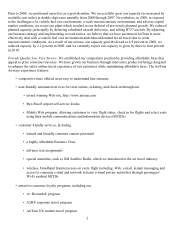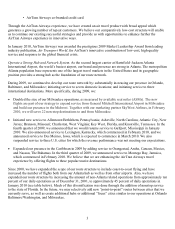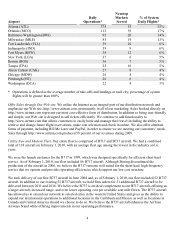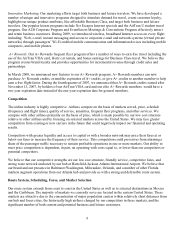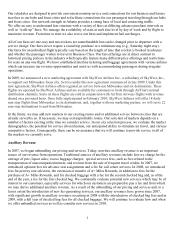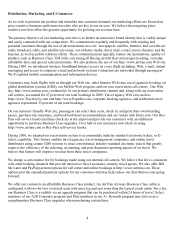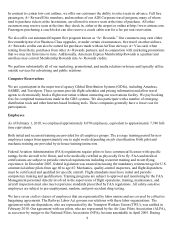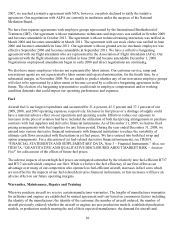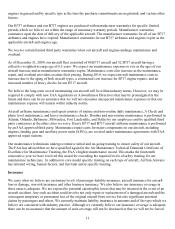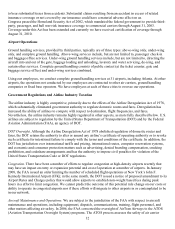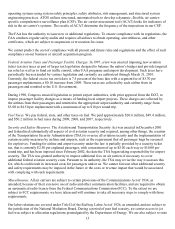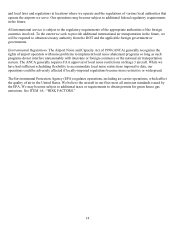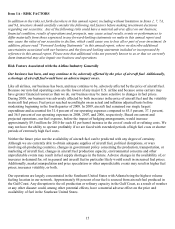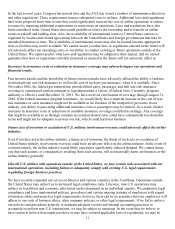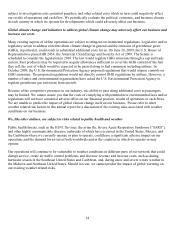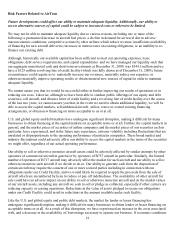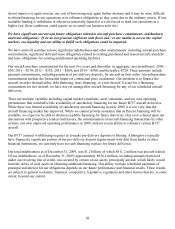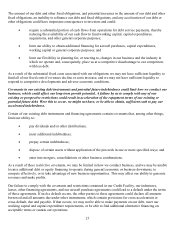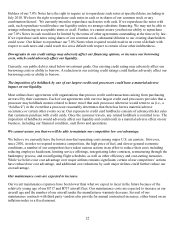Airtran 2009 Annual Report Download - page 21
Download and view the complete annual report
Please find page 21 of the 2009 Airtran annual report below. You can navigate through the pages in the report by either clicking on the pages listed below, or by using the keyword search tool below to find specific information within the annual report.12
to bear substantial losses from accidents. Substantial claims resulting from an accident in excess of related
insurance coverage or not covered by our insurance could have a material adverse effect on us.
Congress passed the Homeland Security Act of 2002, which mandated the federal government to provide third-
party, passenger, and hull war-risk insurance coverage to commercial carriers through August 31, 2003.
Coverage under this Act has been extended and currently we have received certification of coverage through
August 31, 2010.
Airport Operations
Ground handling services, provided by third parties, typically are of three types: above-wing only, under-wing
only, and complete ground handling. Above-wing services include, but are not limited to, passenger check-in
and baggage office services. Under-wing ground handling services include, but are not limited to, directing the
aircraft into and out of the gate, baggage loading and unloading, lavatory and water servicing, de-icing, and
certain other services. Complete ground handling consists of public contact (at the ticket counter, gate and
baggage service office) and under-wing services combined.
Using our employees, we conduct complete ground handling services at 31 airports, including Atlanta. At other
airports, the operations not conducted by our employees are contracted to other air carriers, ground handling
companies or fixed base operators. We have employees at each of these cities to oversee our operations.
Government Regulations and Airline Industry Taxation
The airline industry is highly competitive, primarily due to the effects of the Airline Deregulation Act of 1978,
which substantially eliminated government authority to regulate domestic routes and fares. Deregulation has
increased the ability of airlines to compete with respect to destination, flight frequencies, and fares.
Nevertheless, the airline industry remains highly regulated in other aspects, as more fully described below. U.S.
airlines are subject to regulation by the United States Department of Transportation (DOT) and by the Federal
Aviation Administration (FAA), an agency of DOT.
DOT Oversight. Although the Airline Deregulation Act of 1978 abolished regulation of domestic routes and
fares, the DOT retains the authority to alter or amend any airline’s certificate of operating authority or to revoke
such certificate for intentional failure to comply with the terms and conditions of the certificate. In addition, the
DOT has jurisdiction over international tariffs and pricing, international routes, computer reservation systems,
and economic and consumer protection matters such as advertising, denied boarding compensation, smoking
prohibition, and codeshare arrangements and has the authority to impose civil penalties for violation of the
United States Transportation Code or DOT regulations.
Congestion. There have been a number of efforts to regulate congestion at high-density airports recently that
may have an impact on entry or expansion potential and cost of operation at a number of airports. In January
2008, the FAA issued an order limiting the number of scheduled flight operations at New York’s John F.
Kennedy International Airport (JFK); in the same month, the DOT issued a notice of proposed amendment to its
Airport Rates and Charges policy that would allow airports to establish non-weight based fees during peak
hours in a effort to limit congestion. We cannot predict the outcome of this potential rule change on our costs or
ability to operate in congested airports nor if these efforts will migrate to other airports in or contemplated to be
in our network.
Aircraft Maintenance and Operations. We are subject to the jurisdiction of the FAA with respect to aircraft
maintenance and operations, including equipment, dispatch, communications, training, flight personnel, and
other matters affecting air safety. In 2006, the FAA converted the oversight of AirTran Airways to the ATOS
(Aviation Transportation Oversight System) programs. The ATOS process assesses the safety of air carrier


